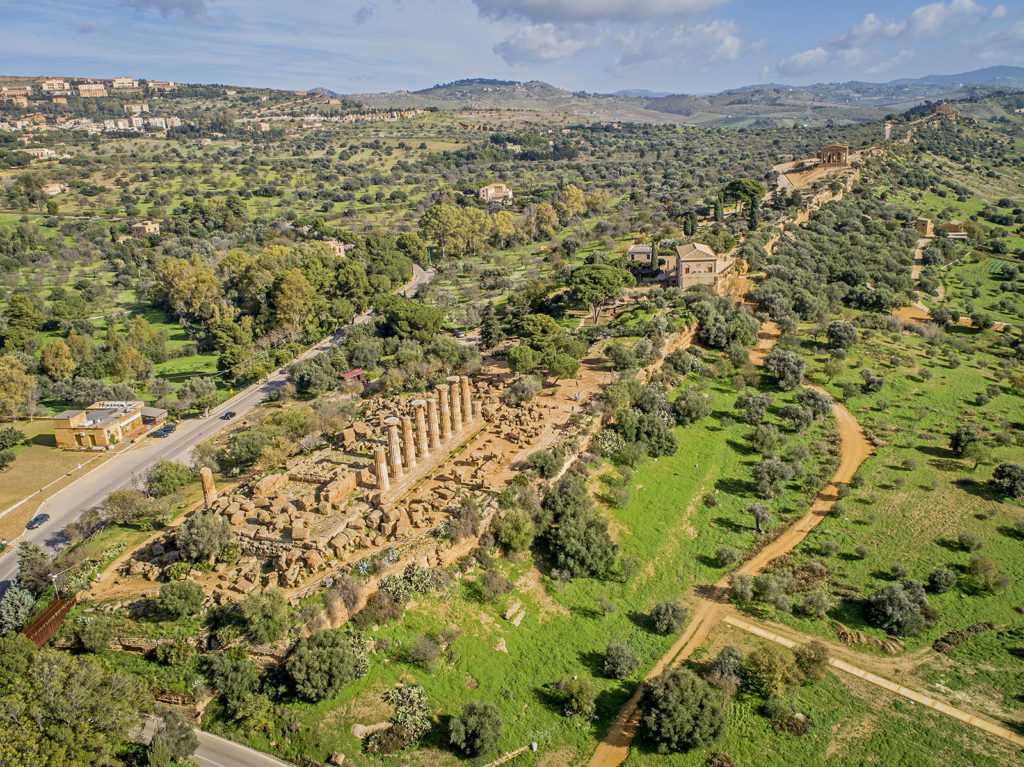The Valley of the Temples is an area that includes the ancient city of Agrigento, founded in 580 BC by Rhodium-Cretan settlers from Gela.
In less than a century it became a power known for its flourishing arts and sciences.
The rediscovery of this site dates back to the end of the 18th century and the integrity of its monuments led it to be inscribed in the World Heritage List in 1997 – the Doric temples that stand on the southern slope facing the sea are iconic.
Agrigento has a special place among classical sites in the history of the ancient world because of the way in which its original site, typical of Greek colonial settlements, has been preserved, as well as the substantial remains of a group of buildings from an early period that were not overlain by later structures or converted to suit later tastes and cults.
Criteria adopted for UNESCO recognition
Criterion (I): The great row of Doric temples is one of the most outstanding monuments of Greek art and culture.
Criterion (II): The archaeological area of Agrigento exhibits an important interchange of human values, being undoubtedly one of the leading cities in the Mediterranean region with its outstanding evidence of Greek influence.
Criterion (III): As one of the greatest cities of the ancient Mediterranean region, Agrigento is an extraordinary testament of Greek civilisation in its exceptionally preserved condition.
Criterion (IV): The temples in the area exemplify Greek architecture and are considered to be among the most extraordinary representations of Doric architecture in the world.
In fact, as you walk within it, you still can experience the ancient splendour of one of Sicily’s most important cities.
The site’s monumental temples, which enjoy an exceptional state of conservation, help to make the powerful image that characterised the city’s development from its foundation until the Byzantine era even more realistic
The incredibly beautiful natural scenery in which the site is located is also a unique example of biological and ecological processes in evolution: hence the need to found the Archaeological and Landscape Park of the Valley of the Temples.

Justifications for the inscription
Agrigento was one of the greatest and most important cities of the ancient Mediterranean world. Its archaeological ruins preserved in conditions of exceptional integrity over time allow us to read its history and evolution from its foundation in the 6th century BC until its partial depopulation and impoverishment, which took place around the 7th century AD.
Fundamental to the expansion and prosperity of Akragas, the ancient name of the city founded by Gela settlers from Crete and Rhodes, were the kingdoms of two tyrants, Phalaris and Theron.
During the hegemony of Phalaris (570-555 BC), defensive walls were built that ingeniously exploited the topography of the terrain and favoured political expansionism, which reached its apex with the tyranny of Theron (488-473 BC).
The victory in the Battle of Himera (480 BC) brought the city great wealth and manpower, giving rise to the monumentalisation of public places with the construction of aqueducts and, above all, Doric temples that still stand in a row on the southern side of the hill: the most majestic are those of Olympian Zeus, Concordia and Hera Lacinia.
In 406 BC the city was besieged and sacked by the Carthaginians, and from that moment until 210 BC, the year in which it officially passed under Roman dominion, then engaged in the Punic Wars, it struggled to regain its ancient splendour and became a prize fought over by the Romans and the Carthaginians.
In the Roman period, Agrigentum had a renewed moment of splendour: during the early years of the Roman Empire; it was the only active
emporium
on the southern coast of Sicily.
This favoured the already flourishing sulphur trade, which led to a new era of prosperity witnessed by the discovery, in the domus of the city, of sumptuous objects and precious mosaics.
The city of Agrigento, in late antiquity and the Byzantine era, thanks to the rise of Christianity, became the seat of a diocese, despite the general decline of the Western Roman Empire and the consequent gradual depopulation and impoverishment that led to the shrinking of the township.
One of its bishops, Gregory, a contemporary of Pope Gregory I, was commissioned to transform the Temple of Concordia into the first cathedral of Agrigento.